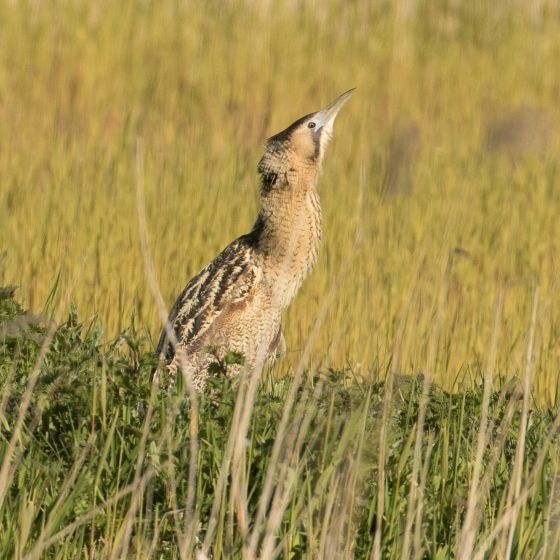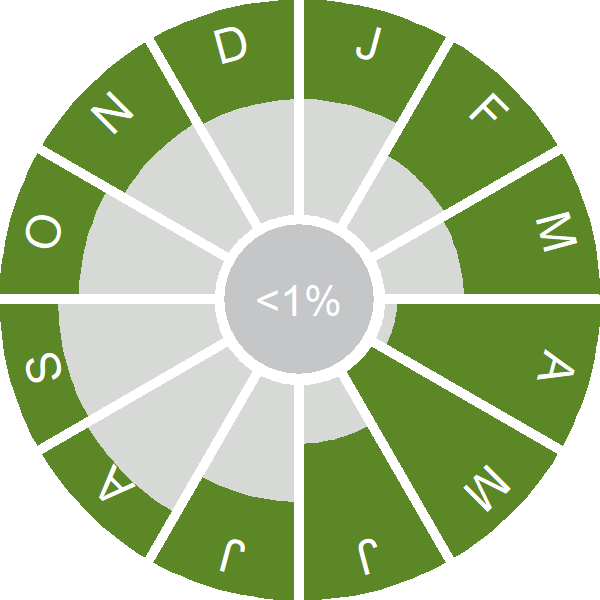Bittern

Introduction
Seeing a Bittern is always difficult, owing to their preference for dense reedbeds and to their strongly cryptic plumage, but they are famous for the far-carrying, booming call of the male in spring.
British Bitterns breed in our largest and least disturbed reedbeds, most often in nature reserves, where they benefit from well-directed conservation efforts and carefully designed habitat creation. When on migration, and in winter, they also occur in smaller and more open wetlands, though still preferring dense cover.
Sonagram analysis of Bittern calls has helped the monitoring of breeding numbers by allowing researchers to identify males individually, while radio-tracking has identified which elements of a reedbed environment are conducive to successful nesting. Conservation interventions have enabled Bitterns to increase their breeding numbers in Britain around tenfold since 2000.

Key Stats
Identification
Songs and Calls
Song:
Flight call:
Status and Trends
Conservation Status
Population Change
Previously widespread, Bitterns becamee extinct in the UK in the late nineteenth century before returning and increasing to around 80 booming males in the 1950s (Brown et al. 2012). The number of Bitterns in the UK then declined to a low of 11 booming males in 1997 (Brown et al. 2012) but has subsequently increased and has been rising consistently over the last ten years, with a new record total of 227 pairs counted in 2019 (Eaton et al. 2021). The breeding range has consequently also expanded considerably over the 40 years since the 1968–72 Breeding Atlas (Balmer et al. 2013).
Distribution
The extensive wet reedbeds that Bitterns require for breeding are provided at clusters of sites in Kent, East Anglia, Somerset and Yorkshire. In winter, Bitterns are much more widespread and can be found at many smaller sites with a mix of reedbeds and pools and also along riverbanks.
Occupied 10-km squares in UK
2007/08–10/11
or view it on Bird Atlas Mapstore.
2008–11
or view it on Bird Atlas Mapstore.
European Distribution Map
Distribution Change
A few areas along the Norfolk and Suffolk coastline, in the Norfolk Broads and in north Kent have recorded breeding Bitterns in all three breeding atlases. Recent gains at inland sites correspond with extensive habitat creation schemes.
Change in occupied 10-km squares in the UK
from 1981–84 to 2007–11
or view it on Bird Atlas Mapstore.
from 1968–72 to 2008–11
or view it on Bird Atlas Mapstore.
Seasonality
Bitterns are recorded throughout the year, but most often in winter and in spring when its territorial booming calls can be heard, and when adults may be seen on provisioning flights.
Weekly pattern of occurrence
The graph shows when the species is present in the UK, with taller bars indicating a higher likelihood of encountering the species in appropriate regions and habitats.

Movement
Britain & Ireland movement
Foreign locations of birds ringed or recovered in Britain & Ireland
Dots show the foreign destinations of birds ringed in Britain & Ireland, and the origins of birds ringed overseas that were subsequently recaptured, resighted or found dead in Britain & Ireland. Dot colours indicate the time of year that the species was present at the location.
- Winter (Nov-Feb)
- Spring (Mar-Apr)
- Summer (May-Jul)
- Autumn (Aug-Oct)

European movements
EuroBirdPortal uses birdwatcher's records, such as those logged in BirdTrack to map the flows of birds as they arrive and depart Europe. See maps for this species here.
The Eurasian-African Migration Atlas shows movements of individual birds ringed or recovered in Europe. See maps for this species here.
Biology
Productivity and Nesting
Nesting timing
Egg measurements
Clutch Size
Survival and Longevity
Survival is shown as the proportion of birds surviving from one year to the next and is derived from bird ringing data. It can also be used to estimate how long birds typically live.
View number ringed each year in the Online Ringing Report.
Lifespan
Survival of adults
Biometrics
Wing length and body weights are from live birds (source).
Ring Size
Classification, names and codes
Classification and Codes
- Order: Pelecaniformes
- Family: Ardeidae
- Scientific name: Botaurus stellaris
- Authority: Linnaeus, 1758
- BTO 2-letter code: BI
- BTO 5-letter code: BITTE
- Euring code number: 950
Alternate species names
- Catalan: bitó comú
- Czech: bukac velký
- Danish: Rørdrum
- Dutch: Roerdomp
- Estonian: hüüp
- Finnish: kaulushaikara
- French: Butor étoilé
- Gaelic: Corra-ghràin
- German: Rohrdommel
- Hungarian: bölömbika
- Icelandic: Sefþvari
- Irish: Bonnán
- Italian: Tarabuso
- Latvian: lielais dumpis
- Lithuanian: didysis baublys
- Norwegian: Rørdrum
- Polish: bak (zwyczajny)
- Portuguese: abetouro
- Slovak: buciak velký
- Slovenian: bobnarica
- Spanish: Avetoro común
- Swedish: rördrom
- Welsh: Aderyn y Bwn
- English folkname(s): Miredrum, Butterbump
Research
Causes of Change and Solutions
Causes of change
Degradation of habitat was considered an important driver of the declines between the 1950s and the late 1990s, with water levels within reedbeds being important (Tyler et al. 1998, Brown et al. 2012). Bitterns require extensive reedbeds for breeding and the recent increases have been driven by conservation efforts which have led to existing reedbeds being restored and new sites being created. Ongoing management of habitat is likely to remain important especially in the face of likely effects of climate change in south-east England (Brown et al. 2012).
More Evidence
More evidence from Conservation Evidence.com
Partners
Citing BirdFacts
If you wish to cite particular content in this page (e.g. a specific value) it is best to use the original sources as linked in the page. For a more general citation of the whole page please use: BTO (20XX) BirdFacts Species: profiles of birds occurring in the United Kingdom. BTO, Thetford (www.bto.org/birdfacts, accessed on xx/xx/xxxx).

